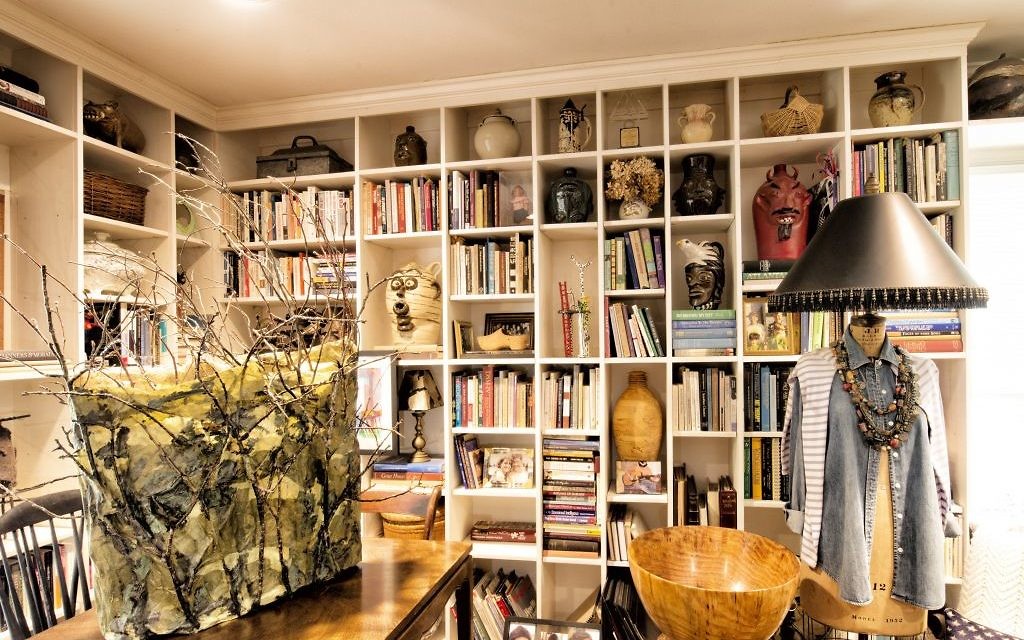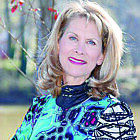Sculptor Layers Colors and Emotions in Enclave
Inspiration form the woods and artists's own pieces adorn Sandy Springs home.

It’s always impressive to visit an artist’s home and see her own work embedded with the verve of others. Phyllis and Lew Kravitz are tucked away in a wooded Sandy Springs enclave where Phyllis’ imagination runs wild with her life-size sculptures, her drawings and paintings, and her handmade vessels.
Her expression comes from within. Her interest in psychology and creation led to art therapy.
Every room, including her studio, has texture, pattern and the intensity of things collected over the years that give a place its soul — a patchwork quilt of collections and color.
Get The AJT Newsletter by email and never miss our top stories Free Sign Up
Wide-ranging influences come to life with antique and primitive furnishings. Nothing overshadows Kravitz’s own work, which has been displayed in New York and various Southern venues, including the Museum of Contemporary Art of Georgia.
Kravitz’s early exposure to design was informed by her family’s involvement in Rich’s Department Store.
Photos by Duane Stork
Jaffe: Were you artistic as a child?
Kravitz: At age 7, we moved to Atlanta from New Jersey. I started ceramic lessons at the High Museum of Art when it was in the original old mansion. I attended Westminster Schools, earned a fine-arts degree at Georgia State University. After a 16-year gap to rear my family, I continued there to earn a master of fine arts in sculpture and took painting from Jack Ramsey, who headed the Atlanta College of Art. After a few years, I returned to college to attend the Vermont College’s art therapy program. I came home to develop the first art therapy program at Hillside psychiatric hospital in Midtown. It was very meaningful to work with emotionally disturbed youth.
Jaffe: You are talented in so many mediums. How did you evolve?
Kravitz: I started as a painter but morphed into a sculptor. When I took a 3D class at Georgia State, I loved working with my hands — molding and layering. Playing with materials to create makes me the happiest. I’ve made art my whole life: collecting branches and burls in the woods to make frames and stones as a child and building in tree roots. Mannes Gallery carried my work in the 1990s. I’m now at Amy Spanier’s I.D.E.A. Gallery in Chamblee.
I am a multimedia artist who depicts human expression. My approach is both experimental and intuitive. The abstracted forms explore the boundaries of space and containment. I hand-build my forms over armatures that are bent and shaped to capture expression. I began making vessels when I realized the symbolism of holding. That led to the idea of a body as a vessel: stories, memories, joys and sorrows. I build my pieces using layers of materials, implying what we as humans carry inside. In my most recent sculptures, the bodies are open and hold scrolls with writings and poems.

For my large human figures, on which I spend the most time, I use PVC pipe, paper, resin, wire and paint. I rarely do expressions on faces. I create flow and positioning to imply feelings.

Jaffe: Describe the bones of your house.
Kravitz: It was built in 1960 by Earl McMillen. We moved here in 1971 because we loved the idea of being surrounded by woods while being close to the city. Through the years the house décor changed, and I began using color to define the rooms. We like the contrast between traditional and contemporary and house my own art along with antiques and other collections.

Australian shepherd mix Buddy finds house nooks in which to watch the wild creatures outside and keep his job protecting the house. We added a porch and waterfall to hear the sound of water.
Jaffe: What are some of the unusual pieces here?
Kravitz: We have a bowl from the Adirondacks carved from a burl with a bear on its rim, a 1750 plate rack and table, a French cafe chandelier, an Old English clock and Charlie West’s roosters.
Jaffe: Folk art allows a sense of humor.
Kravitz: We have carved wooden Civil War soldiers — “Blue vs. Gray” by a man named Rooster — fighting on the battlefield. Only the Union soldiers are dying and bleeding. The twist in this piece is the Confederate soldiers are “winning.”

In the entrance, we have a sculpture by Andrew Crawford of a pear vine growing out of the floor. We have pieces by Jack Ramsay, Jim Sudduth, Cornbread, Thornton Dial and this wild devil by R.A. Miller — note his red tongue against the somber black and white.


Jaffe: How would you describe your home’s style?
Kravitz: The house is eclectic. My husband and I love color. Lew, a Georgia Tech graduate, designed and built our playroom with a vaulted and beamed ceiling. He has been a tremendous support for me as an artist — gives feedback, moves pieces, constructs rolling tables and mounts for my pieces. His technical knowledge helps me in numerous ways.

We are attracted to folk art and its energy. The hall walls are faux-painted in a burnished yellow and ochre with a touch of green rubbed in; the living room, a deep autumn maple orange-red; the kitchen, rich turquoise, deep aquamarine; and orange imari fabric on the walls in the sitting room.

Jaffe: What goes on in your studio?
Kravitz: It takes about five months to complete a figure. I work fast, but the drying time is long. I use clay, wax, dry materials and resins. When creating a wax vessel to be cast in bronze, I take it to a foundry, where they use the lost-wax method to cast and then patina the sculpture. I studied under George Beasley and learned bronze casting.

I work five hours a day, five days a week, listening to country music or slow jazz and classical. Once I’m into the flow of work, I hear very little of the music. I’m not shy about getting my hands or the rest of me dirty.





comments